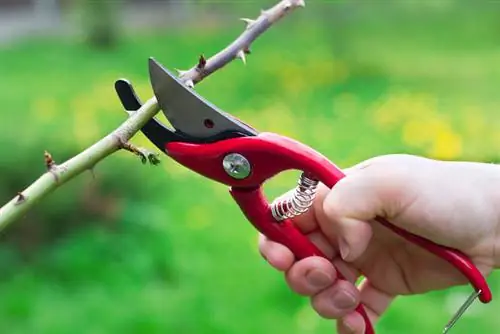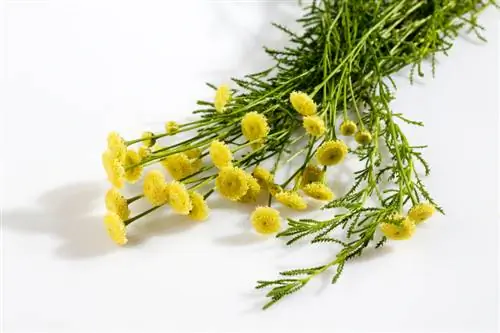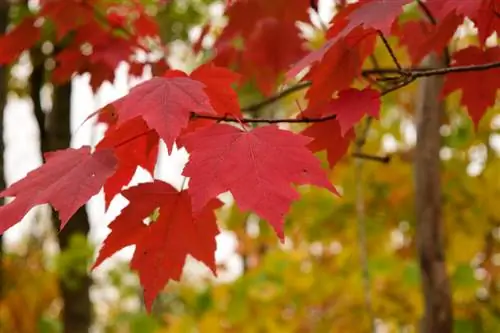- Author admin [email protected].
- Public 2023-12-16 16:46.
- Last modified 2025-01-23 11:20.
Even if it seems unbelievable given the many publications on the subject, almost all of which contain complicated pruning rules, roses are among the most pruning-friendly trees. Regular pruning promotes he alth and abundance of flowers and also extends the lifespan of the rose. In this article we have put together which pruning measures should be taken at which time of year.

When should you cut roses?
Roses should be pruned in spring (late March to early April) and after flowering in summer. In spring, roses that bloom more often are cut back and all roses are thinned out. In summer, roses that bloom once are pruned and dead shoots are removed.
Cut back more frequently blooming roses in spring
Most gardeners probably know that roses are usually pruned in spring: an old rule states that pruning should be done when the forsythia are in bloom - this is usually between late March and early April. In principle, this statement is correct, with one exception: once-blooming roses (which include almost all historic roses) are always cut back after flowering in summer, as they only bloom on previous or perennial wood. Spring pruning is only carried out on rose varieties that bloom more often (which includes all modern roses). With these, pruning promotes new shoots and, since modern roses bloom on annual wood, also the abundance of flowers in the same year.
Thinning out and rejuvenating all roses in spring
But no matter whether they bloom once or repeatedly: all roses must be thinned out in spring, and in particular frozen and diseased shoots must be removed. These are shortened to the base or to the he althy wood. Cut back into the he althy marrow until it looks greenish-white and no longer shows any brown spots. In addition, remove all thin and weak shoots, as these cannot bear flowers anyway and thus only rob the plant of strength. Do not leave any shoot stubs standing: these are vulnerable areas for fungi.
Summer pruning keeps roses fit
Summer pruning measures are an important way to stimulate the willingness and abundance of flowers. This will extend the rose bloom until autumn. You can also undertake a topiary cut for once-blooming old roses and ramblers in the warm summer months.
Extend the flowering period by pinching
After the often exuberant abundance of flowers in June, there comes a phase for all roses in which only a few flowers can be seen. Most plants first have to gather strength for the next flowering, so - at least for the more frequently flowering varieties - it is a kind of resting phase. You can sometimes get around the break in flowering with a trick called pinching. Proceed as follows:
- Before the first flower blooms, remove up to a third of the shoots including buds.
- Since this pile is often very lush, you will most likely not even notice it is missing.
- By removing it, the eyes underneath immediately pop out again
- and bloom exactly when the first flower has faded.
Cut back faded flowers
After flowering, the faded shoot is cut back to the next complete leaf. If you look closely at the dead shoot, you will see that there is no complete multi-part leaf directly under the flower. This sheet only has one to three parts. Only the second or third leaf below is fully formed, i.e. H. it has five, seven or even nine parts, depending on the variety. Now cut off the withered shoot directly above this leaf and the eye will sprout again. New flowers usually form within the next six weeks. For cluster-flowered roses, wait until all the flowers have faded. Then you can cut the entire inflorescence back to a fully developed leaf.
Topiary cutting for once-blooming roses
All roses that bloom once should be shaped immediately after flowering. In contrast to pruning the varieties that bloom more often, old shoots are only removed now. The newly growing shoots will then bear flowers the next year. Old roses tend to have long, lateral shoots that lie on the ground or grow far into the other plants. You can cut them back without any disadvantages or use them as a plant for propagation. For rambler and cascade roses, shorten long shoots after flowering and take older shoots back to the base.
Pruning roses in the cold season
Autumn pruning is mainly carried out for he alth reasons in order to prevent infestation with the typical rose diseases. Cut back dead plant material before the winter break to eliminate possible sources of infection. Dead shoots are preferentially colonized by fungi and bacteria, which in turn cause rot and infections. To avoid this, cut back all weak and thin shoots shortly before winter - when there have already been the first frosty nights. This means that dead wood cannot form in the first place and fungi have no chance.
Tip
Wild shoots should always be removed in good time, because if they sprout below the grafting point, they can completely overgrow a rose. As a result, it dies and the wild rose rootstock takes its place. Don't just cut the shoot off - otherwise it will always grow back. Use the spade to expose the grafting area and tear off the shoot with a twisting motion.






